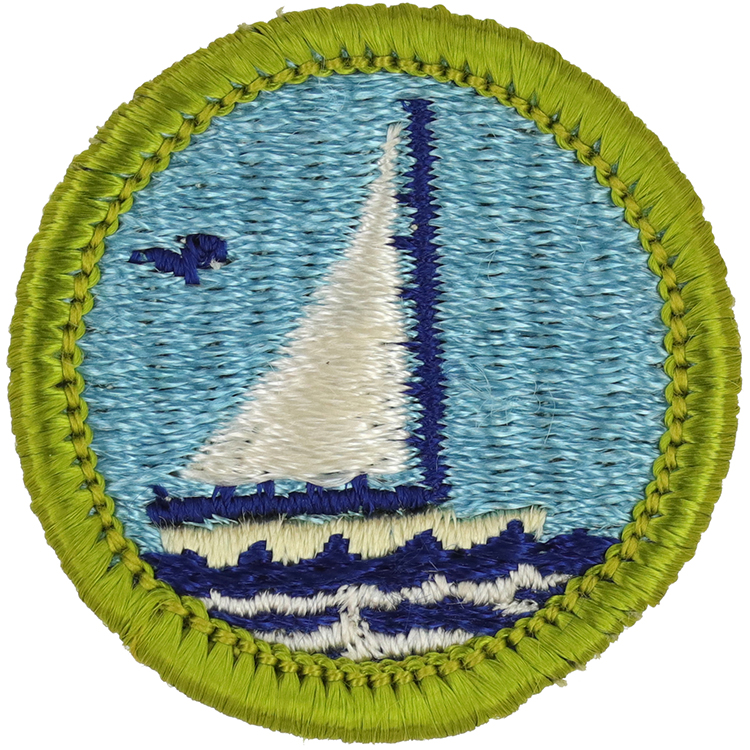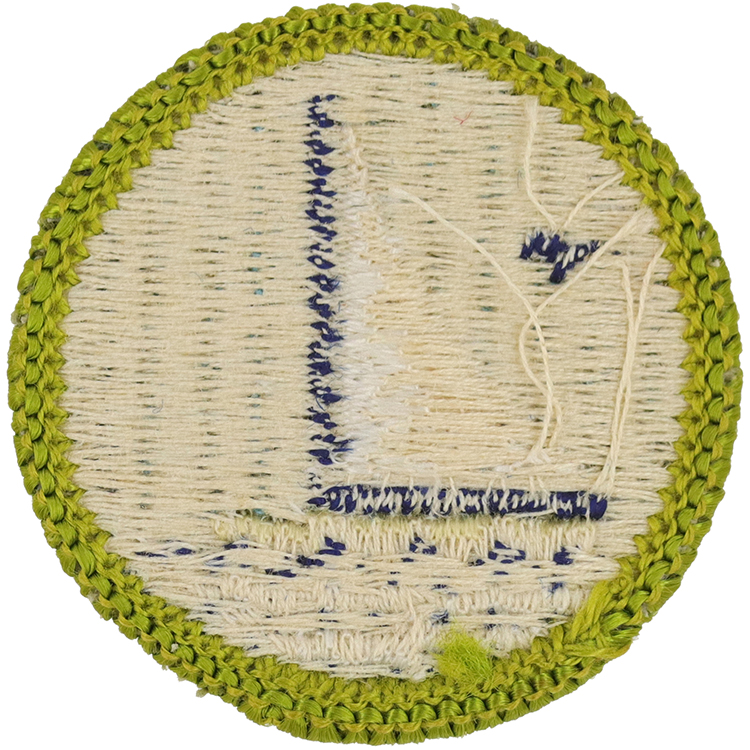
Fig. 1: SmaSai-G-Front
- Embroidery: Cotton thread
- Border: Merrowed

Fig. 2: SmaSai-G-Reverse
- Back: Starched cloth
Item Name: Small Boat Sailing 1964 - 1972
Item ID: SmaSai-G
Collector Rating: 1
Requirements January 1965 until June 1972
Before earning this merit badge, complete First Class Test 8 and earn your Swimming and Rowing merit badges.
1. Describe to your counselor:
(a) The following types of sailboats--sailing dinghy, catboat, yawl, sloop, ketch, schooner, cutter, and catamaran.
(b) The following types of sailing rigs--lateen, Marconi, leg-o-mutton, spritsail, standing lug, and sliding gunter.
(c) The following types of sails--jibs, spinnaker, mainsail, staysail, foresail, mizzen, and jigger.
2. Sketch a Marconi-rigged and a gaff-rigged sloop and show on each sketch:
(a) The names of the sails and spars.
(b) The names of the sides and corners of all the sails.
(c) The names of the essential parts of each of the two types. Explain their use to your counselor.
3. Tell the general purpose of and the difference between the centerboard, the keel and dagger board, the bilgeboard, and the leeboard.
4. Describe how you would care for and maintain the hull, sails, and equipment of a sailboat during the boating season and between boating seasons.
5. Show a knowledge of marlinspike seamanship.
(a) Demonstrate how to tie and tell the uses of the following knots, bends, and hitches: square or reef knot, clove hitch, single bowline, figure-eight, sheet bend, slipknot, mooring hitch, and round turn with two half hitches.
(b) Show how to secure sheets so they don't jam. Properly coil and hang sheets or halyards.
(c) Demonstrate the following: long splice, short splice, and eye splice.
(d) Describe whipping, worming, parceling, and serving.
(e) Show how to heave a line and how to belay.
(f) Describe the types of fibers used in rope and the advantages of each.
6. Know the sailing rules of the road, including the following:
(a) government rules of the road compared with the yacht racing rules in our locality.
(b) Rules concerning night-lights on sailboats in coastal and inland waters.
(c) How a sailboat legally becomes a motorboat.
(d) When a sailboat is required to keep clear of a motorboat.
7. List the safety equipment and safety rules that are required on a sailboat when under way.
8. Describe the safety procedures to use in the following emergencies: assisting others, bad weather, and running aground.
9. Demonstrate the safety rules to use in the following emergencies: capsize, man overboard, and picking up a towline.
10. Explain: center of effort, irons (in irons), luffing, apparent wind, loose-footed, wing and wing, and one design.
11. With the help of a crew member and using proper safety precautions, demonstrate the ability to sail a boat properly on all points of sailing.
(a) Getting under way from a mooring or dock.
(b) Setting the sails.
(c) Beating, reaching, and running.
(d) Jibing properly.
(e) Reefing.
(f) Anchoring.
(g) Landing at a mooring or dock.
(h) Furling or stowing the sails.
12. Give a brief history of the America's Cup.
Requirements September 1970 until June 1972
Before earning this merit badge, complete First Class Test 8 and earn your Swimming and Rowing merit badges.
1. Describe to your counselor:
(a) The following types of sailboats--sailing dinghy, catboat, yawl, sloop, ketch, schooner, cutter, and catamaran.
(b) The following types of sailing rigs--lateen, Marconi, leg-o-mutton, spritsail, standing lug, and sliding gunter.
(c) The following types of sails--jibs, spinnaker, mainsail, staysail, foresail, mizzen, and jigger.
2. Sketch a Marconi-rigged and a gaff-rigged sloop and show on each sketch:
(a) The names of the sails and spars.
(b) The names of the sides and corners of all the sails.
(c) The names of the essential parts of each of the two types. Explain their use to your counselor.
3. Tell the general purpose of and the difference between the centerboard, the keel and dagger board, the bilgeboard, and the leeboard.
4. Describe how you would care for and maintain the hull, sails, and equipment of a sailboat during the boating season and between boating seasons.
5. Show a knowledge of marlinspike seamanship.
(a) Demonstrate how to tie and tell the uses of the following knots, bends, and hitches: square or reef knot, clove hitch, single bowline, figure-eight, sheet bend, slipknot, mooring hitch, and round turn with two half hitches.
(b) Show how to secure sheets so they don't jam. Properly coil and hang sheets or halyards.
(c) Demonstrate the following: long splice, short splice, and eye splice.
(d) Describe whipping, worming, parceling, and serving.
(e) Show how to heave a line and how to belay.
(f) Describe the types of fibers used in rope and the advantages of each.
6. Know the sailing rules of the road, including the following:
(a) government rules of the road compared with the yacht racing rules in our locality.
(b) Rules concerning night-lights on sailboats in coastal and inland waters.
(c) How a sailboat legally becomes a motorboat.
(d) When a sailboat is required to keep clear of a motorboat.
7. List the safety equipment and safety rules that are required on a sailboat when under way.
8. Describe the safety procedures to use in the following emergencies: assisting others, bad weather, and running aground.
9. Demonstrate the safety rules to use in the following emergencies: capsize, man overboard, and picking up a towline.
10. Explain: center of effort, irons (in irons), luffing, apparent wind, loose-footed, wing and wing, and one design.
11. With the help of a crew member and using proper safety precautions, demonstrate the ability to sail a boat properly on all points of sailing.
(a) Getting under way from a mooring or dock.
(b) Setting the sails.
(c) Beating, reaching, and running.
(d) Jibing properly.
(e) Reefing.
(f) Anchoring.
(g) Landing at a mooring or dock.
(h) Furling or stowing the sails.
12. Give a brief history of the America's Cup.

